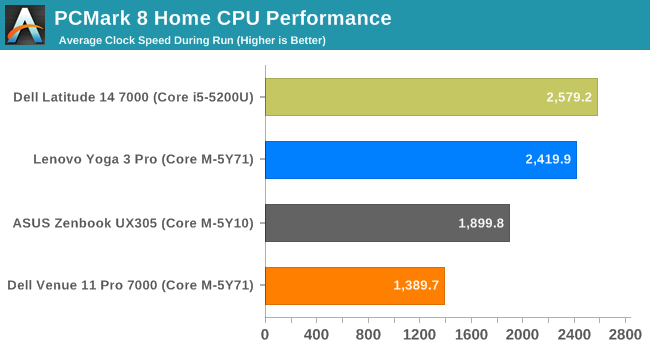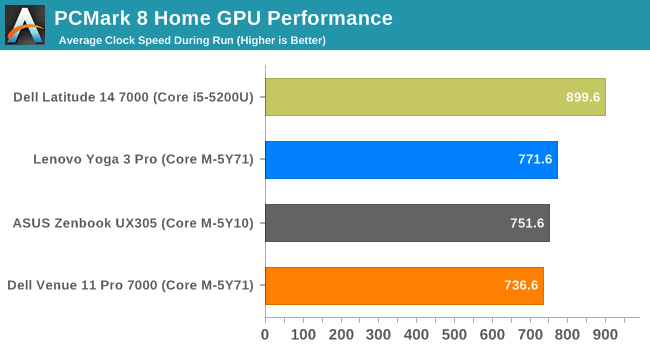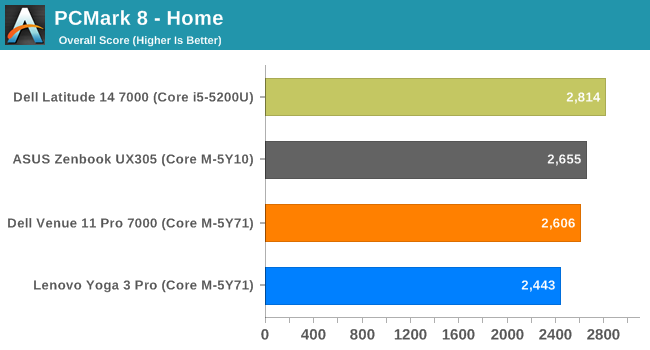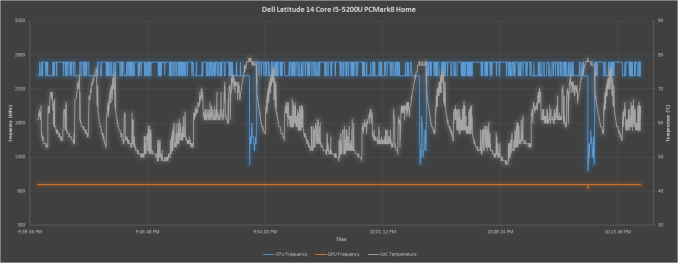Analyzing Intel Core M Performance: How 5Y10 can beat 5Y71 & the OEMs' Dilemma
by Brett Howse & Ian Cutress on April 8, 2015 8:00 AM ESTPCMark 8 Home Results
PCMark 8 Home is a much different workload than Cinebench. Cinebench thrives on sustained performance over the duration of the workload, with the CPU utilization staying around 100% for the duration. While an important metric, most people do not use their computers like that in their day to day lives, so Futuremark has crafted the PCMark suite to perform tasks which are more akin to what the average person will do in a day. Home includes workloads for web browsing, writing, gaming, photo editing, and video chat, and the nature of these loads mean that there is a lot more burst performance needed, so the race to sleep mentality of the Core M can be more effective in this scenario.
The burst nature of this benchmark is apparent just looking at the Core i5. No longer is the CPU frequency consistent across the board, and the temperatures ramp up and down as the work is performed and finished. Even more pronounced is the Dell tablet, which spikes up and down from its maximum temperature, but at the same time ramping clock speeds up quite high as well. The incredible cooling of the ASUS UX305 passive solution makes a big difference here, with the UX305 being able to maintain almost its maximum frequency for the duration of this benchmark. The Yoga 3 Pro really shines here though, with it maintaining quite high speeds for almost the entire duration of the benchmark.

Average CPU frequencies on the other hand show an unexpected disparity between the results we saw above and what the averages end up being. It's the cool Yoga 3 Pro that holds the highest average clockspeeds, followed by the UX305, and finally bringing up the rear is the Venure 11 Pro 7000.

The GPU averages for the three Core M devices are very similar overall, although none are at their maximum. Only the 15 watt Core i5 can maintain its maximum GPU frequency for the duration of this test. As we will see later, GPUs can draw a lot of power.

Moving on to temperature, with the burst nature of this benchmark, all of the devices have a reasonable time to cool off between workloads. The ASUS shows its amazing cooling capabilities again, with a significantly lower temperature than even both of the active cooled devices, but none of them are too close to their maximum allowed temperature over the duration.

Looking at the end result of this benchmark kind of throws everything we have seen in the above graphs on its head. The Yoga 3 Pro, despite sustaining a CPU frequency higher than all of the other Core M devices in this test, ends up scoring the worst, however the overall result by the Yoga 3 Pro is disadvantaged in this benchmark by the gaming test, due to the high resolution display on the Yoga 3 Pro. This is very similar to the results seen in the Dell XPS 13 review, where the QHD+ model only scored 2691 and the FHD model scored 3042 with the same processor. However the ASUS UX305 beats the other Core M devices, although it does so with a much lower resolution display than the Yoga 3 Pro which would certainly beat it otherwise.














110 Comments
View All Comments
OneCosmic833 - Friday, April 10, 2015 - link
I don't really understand, why don't the manufacturers put a little bigger heatsink with a FAN of bigger diameter into these portable devices, is it such a problem??? Production costs reduction or bad engineering? I think it would be also possible to keep the same weight if they cut some bulk mass from somewhere else of the device. Simply this throttling is not acceptable for me and an i7 should not have lower performance than i5 in sustained load...This is very very sad for us consumers, like how the manufacturers skimp us ! ! !metayoshi - Friday, April 10, 2015 - link
Great article!I'm very interested in this, though, after reading the whole article: I noticed the Asus laptop with the metal chassis was the one with the 5Y10, and the two devices that are usable as a tablet/is a tablet are the two devices with the 5Y71. However, I know that the Venue 11 Pro comes with a 5Y10 for its base configuration, so it would be interesting to see how that 5Y10 version compares vs the 5Y71 version, knowing it is thermally handicapped compared to the Lenovo, with its fan, and the Asus, which is a laptop with a metal chassis.
I was originally eyeing the Venue 11 Pro, but I jumped on the preorders of the less powerful but still capable Surface 3 with the new Atom SoC. I'm really intrigued by Core M, but all these stories of throttling and whatnot are keeping me away for now.
serendip - Friday, April 10, 2015 - link
Intel has a decent mobile chip with Atom. Core M, not so much. I would rather have a slower Atom chip that costs a lot less and can turbo for long periods than a Core M with much higher performance that isn't accessible to the user thanks to constant throttling. Maybe there should be a caveat on Core M devices like "2.4 GHz processor (for 10 seconds only), base 1 GHz". That way consumers know what they're really in for.ahfei - Tuesday, April 14, 2015 - link
Is 2.6GHz the maximum turbo speed for M-5Y71 for 2 cores, judging from the graph? Cannot find that info anywhere and some even stated the maximum 2.9GHz is for both cores!Brett Howse - Sunday, April 19, 2015 - link
I have never seen them go over 2.6 GHz for both cores. 2.9 GHz seems to be just for a single core.boe_d - Saturday, April 18, 2015 - link
I like the Sony Vaio Z approach - balls the walls hardware, fast processing power, fast storage, fast video and LIGHT. Still lighter than most laptops 5 years later and faster than many of them too! Battery power wasn't great but it had an easy to replace battery.RanBuch - Saturday, July 18, 2015 - link
I own a Lenovo yoga 3 pro. Can I configure the SoC temperature from 65°C to a higher value? I use the device as a "desktop" more often then a tablet and would love to get more juice from my machine even at the expense of the device "overheating" a little bit.HP - Wednesday, August 5, 2015 - link
These processors are perfectly decent. But at the same time, really novel due to the fact that no active cooling is required to run them. This in my view is a positive progression in CPUs together with the SoC philosophy. To have everything integrated into a smaller space. Many users might complain about performance but I bet they don't use their i5 or i7 machines to the fullest potential either. Core-M performance is perfectly decent. Granted, the only slow downs I have experienced is when compiling a Linux kernel say or running multiple FHD videos. But such tasks are run on a less than regular basis so a slight slow down in speed during these exercises is acceptable. The rest of the tasks get carried out very well in a thin, light and quiet design.Atreyiu - Tuesday, February 2, 2016 - link
I know many will disagree with me, but I am a regular user and I hate when my Venue 11 Pro 7140 (5Y10, 64 Gb, 04 Gb RAM) is heated so much that I can not put my right hand in it, that temperature is unbearable from 55 ° C upwards. Should not rise beyond what your skin can handle. This happens pretty and very quickly, then to lower spend enough time. I'm thinking let go of it and look for an alternative. I wanted a balanced team between productivity and way of life, but these temperature rises disenchanted me and the only thing that bothers me because it is fast and has no crashes or anything like that.SandraGok - Tuesday, June 9, 2020 - link
I'm not just inviting you! But it will be interesting for sure loveawake.ru